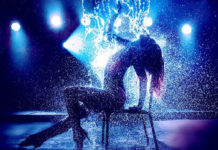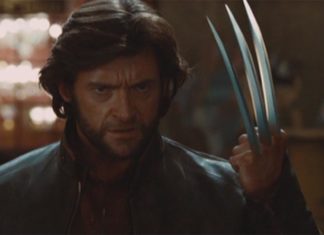Sex (And Sex Differences) Have Always Been A Part of Art (and Comics!)
So, to recap: the males of the species have always liked physically attractive and obviously fertile young women, and always will. It is hard-wired into us. This preference has always manifested in visual art (including comics), and always will. To review the evidence:
1. Ancient Fertility Idols

2. Xochiquetzal

I touched on Xochiquetzal last time, but she’s worth revisiting because, unlike some of the less-famous or less-specific fertility idols shown above, depictions of Xochiquetzal have continued well into modern times. And it shouldn’t surprise you to learn that those depictions look strikingly similar to the depiction of super heroines and other comic book illustrations of women today.
You’ll notice in the examples below that, in modern depictions, the emphasis is no longer directly about birthing a baby, and the facial expression is not about grimacing through the pain of childbirth. Rather, youth, fitness, firm breasts, lustrous hair, and skin-clarity are all emphasized. And the expression is one of general happiness or sly knowing, either of which can be at least partially considered signs of availability to mate. That is: signs of ovulation.
Seriously, these depictions of Xochiquetzal could come from any comic book or graphic novel. There’s a pretty straight line to be drawn here.

3. Depictions of Women Being Fertile and Sexually Available Have Always Been With Us
And always will be, as long as we are still human. This isn’t even honestly debatable.
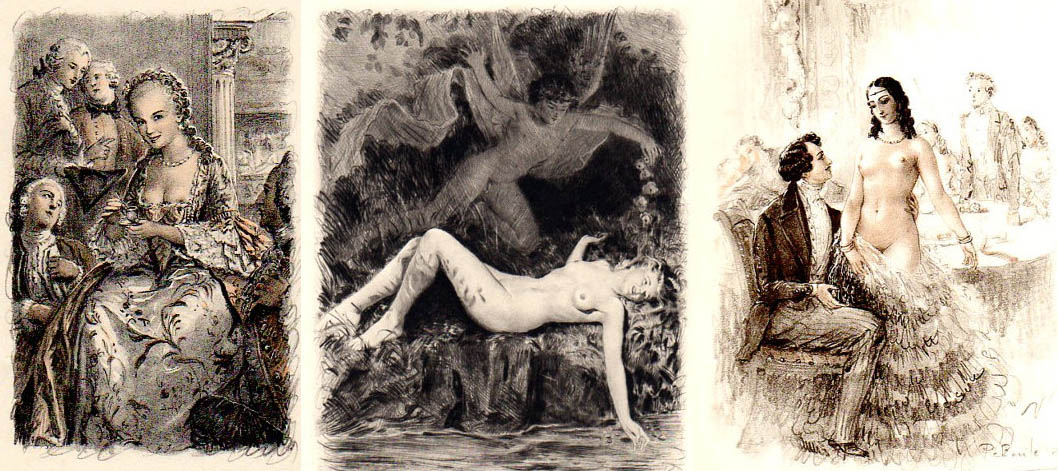
4. Heroism, War, Competition, and Sexy Ladies Have Always Been a Thing
Also, sexy ladies, war, competition and heroism have been concepts that have been tied together since the beginning of human history. Comic books are just another manifestation of that. The point being: there is nothing new here, and it’s hard-wired and natural, not the product of an arbitrary social construct.
So, now that we’re all caught up, I’m going to spend a little time making two additional points:
- Secondary sex characteristics are showcased in comic books because, as with fertility idols and Renaissance art, humans find such things interesting and compelling, especially men, as they are generally more sexually responsive visually than women.
- Despite popular arguments to the contrary, men and women both routinely exhibit secondary (and tertiary) sex characteristics in comic books. They just aren’t identical, because men and women are not identical.
Secondary and Tertiary Sex Characteristics In Super Women
So here’s a list. It’s not all-encompassing and mixes secondary and tertiary sexual characteristics with things that are simply factors when instinctually evaluating fertility. Still, I tried to be as comprehensive as I could.

Men respond to such things because they are hardwired to do so by evolution. Visually, such things work for them in general, so constitute a great way to make the constant repetition of seeing the character (not to mention repeatedly drawing the character) interesting to men while they read.
Breasts are an obvious identifier of womanhood and may be instinctually judged (incorrectly) to indicate how well the female is prepared to nourish young. Hip-to-waist ratio is an indicator of how likely the woman is to be able to successfully deliver offspring.
Ironically, the hip-to-waist ratio of Weapon X up above is likely too high to allow her to successfully gestate a child. But such hip-to-ratios don’t exist in the real world, so an attraction to supernormal hip-to-waist ratios was not selected against during evolution.
Hip-mobility (demonstrated with poses, high-kicks, superhero-landings, and back flips) and having a nice butt speak to both general health and capacity to squeeze a baby out. While perhaps unnecessary when saving the universe, such features never-the-less manage to attract the attention of male comic book geeks with money in their pocket.
Why Should Super-powered Women Be Healthy?

Clear skin indicates health. Why would most super heroines be invulnerable but have acne, anyway?
Healthy hair indicates cleanliness, being disease free, capability of self-maintenance, and an ongoing history of health.
General fitness suggests a woman is capable of having sex, gestating a child, and giving birth and living to nourish and raise young. And also passing along healthy genes to your offspring.

Cleanliness and hygiene speak to health and the female’s ability to birth and raise offspring.
Being naked is suggestive of both sexual availability and having no health issues to hide.
Apparent Sexual Arousal is a Tertiary Sex Characteristic

Being sexually available and aroused is generally a sign of ovulation, suggesting not only is the female available as a mate, but that she is fertile and ready to help you pass on your genes.
Happiness and fun-loving—or any other slate of positive, tertiary sexual characteristics—suggests both long-term suitability for pair-bonding and an availability for mating. Ever wonder why that guy you were just trying to be nice to mysteriously mistook that for sexual interest?
So I don’t think it should be a surprise that artists depicting a larger-than-life world filled with idealized supermen and superwomen would also depict them as both physically and sexually ideal. And, of course, they do. And will keep doing so, as long as there are comic books to buy. Or they want their comics to be bought.
But The Super Men Are Never Depicted Like This! This is Sexist!

I’m going to argue that men are also depicted with exaggerated or idealized secondary and tertiary sexual characteristics, but that these characteristics are different.
I’m not going to argue that it’s not sexist in terms of, in some ways, treating the sexes differently. But not in the sense of attempting to diminish women in comparison to men or being “unfair” to women. I don’t believe most female characters are treated unfairly in comic books because they are depicted as sexually desirable, nor do I believe their supernormal sexuality is intended to, or does in fact, diminish them—or women generally—in any way.
The plots of some comics and the editorial tendencies of some books is a different issue. I am not dealing with plot-devices and writing cliches in this series of articles. Just the supernormal stimulation of idealized, superheroic bodies.
There’s a Difference Between Exaggerating Muscles and Exaggerating a Woman’s Butt
Or so says Reel Girl at her blog, asserting as self-evident something that seems patently incorrect, to me. She says:
“Whenever I blog about the exaggerated breasts or ass of a female cartoon character, commenters respond that I have nothing to complain about: all cartoons are caricatures.
“There’s a difference between exaggerating muscles and exaggerating someone’s butt.”
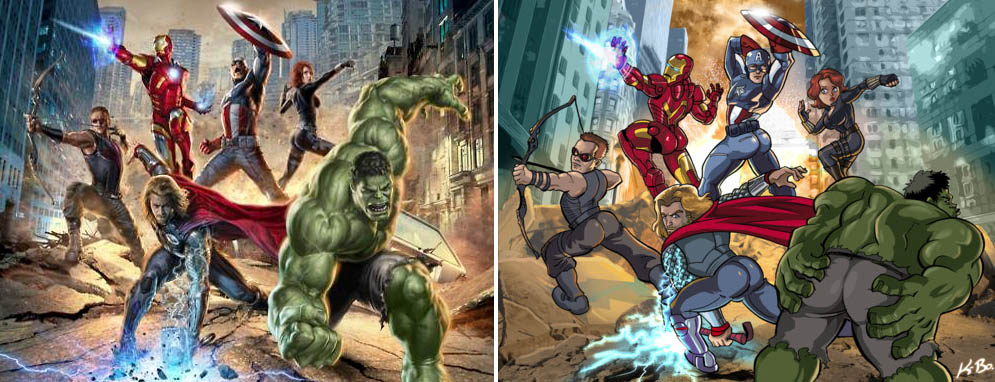
As illustrated above, you can get the idea about what her complaint is.
It’s not just the big boobs and unbelievable hip-to-waist ratio, it’s how they are dressed and posed as well. There’s a simple reason for this difference however: men are more interested in both seeing and drawing women’s butts than men’s butts—that’s just evolutionary science! — and women are, frankly, less interested in seeing a dude’s tight buns than men are in the feminine posterior.
It’s just a difference. One isn’t worse than the other or better than the other. But men and women are not the same, and that’s okay.
Boobs, Butts, And Big Old Muscles
Also, there is no difference between exaggerating boobs and butts on female characters and exaggerating traps and biceps on male characters. It’s the emphasis of the characteristics that demonstrate health and sexual fitness for the respective sexes.

Having Attractive Women Depicted in Sexy Poses Is Not The Same as Excluding Them From Geekdom Entirely
Another thing I see frequently in arguments which assert that “it’s bad that comic book women are sexy” is evidence-by-conflation. That is, they discuss things such as the lack of female artists in the bullpen and the under-representation of women in comic book superhero groups.
These are much more plausible arguments, but they are about different things. They have nothing to do with scantily clad women fighting crime.
In the case of Reel Girl‘s post, she states that female characters account for only 16% of characters in movies for kids (can’t find that documented, but there is this). The relationship between that complaint and the depiction of comic book ladies as sexually attractive seems very thin, to me. These are separate issues. Treat them separately.
Not everything is the same category. Men finding fit, healthy women sexually appealing is just not in the same category as women being under-represented in The Avengers or Justice League or in Hollywood generally.
Sexism is Destroying The Comic Book Industry

“Sexism is Destroying The Comic Book Industry”, insisted The Week in 2013. While this may or may not be true behind the scenes, in terms of comic content it seems far less likely to be reflective of what is happening.
Highly sexualized women were featured prominently in comic books in the 70s and the 80s and 90s. In the context of the time, Wonder Woman was sexualized, and hinted at BDSM from the very beginning.
And though it is not the topic of this series, much of the more sexist and and female-minimizing writing was done in the 60s and 70, and comics still performed well in a much more title-diverse and arguably saturated market.
The comic book industry was considered reasonably robust in 80s and 90s. Certainly, they’ve become more sexualized in the 1990s and 2000s. Yet comics overall continue to do well.
Comics Keep Making Money Even With Sexy Women In Them

The trajectory of revenues in the comic book industry has continued to go up, year-over-year. There no actual indication that the comic book industry was being destroyed in 2013 (by sexism or anything else) or is being destroyed now.
The only possible exception might be Marvel’s recent swing to emphasizing more politically correct narratives, and then cancelling most of their “diverse” titles due to poor performance.
Although there is evidence that the diverse titles sell well in trades, they do not perform well as single-issue releases. As to if the revenue from trades justifies producing the low-selling single-issues is another question.
Perhaps one approach might be for someone who is not Marvel or DC to move into an all-digital market for comics of normal looking women doing boring things for single issues, and only do trades for publication. However, if advocates of realistic representation wait for DC or Marvel to do this, they will be waiting a very long time.
You Can Be Sexy and Diverse

Another problem with the arguments against the depiction of attractive women in sexual poses in comics is the assertion, explicit or implicit, that such depictions are anti-diversity.
They aren’t. You can diversify your offerings without completely abandoning what has worked and and probably always will work.
Gay characters and more female-centric comics and more women in the Avengers doesn’t mean you can’t still have highly-sexualized women saving the world, too.
Nor does one company have to be everything to everybody. If there’s a real market there, then it represents an opportunity. Rather than bitch about what Marvel and DC are doing, they should go make their own comics.
Haranguing DC and Marvel is not a solution.
Marvel couldn’t cancel their diverse titles fast enough, and doesn’t seem to be in a big hurry to do more to clothe their female characters. Because attractive women in sexual poses and situations get attention and generate sales. Especially if those women have superpowers.
But Why Can’t Men Be Scantily Clad and In Sexy Poses?
They can be! And they often are. But more importantly, they commonly manifest the secondary and tertiary sexual characteristics that women instinctually find important criteria in the consideration of mating, or that men instictually believe they do.
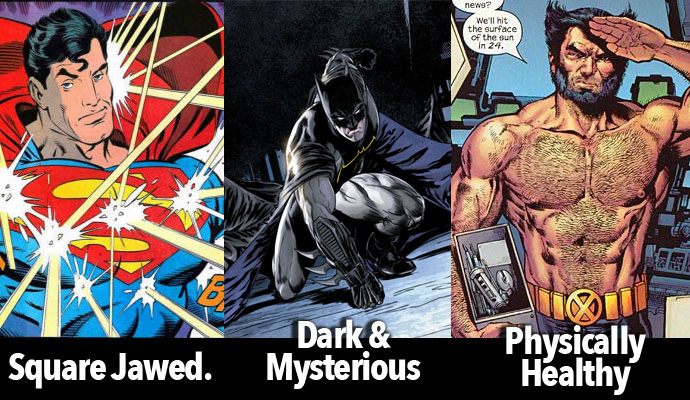
If you’re a guy, it’s good to be fit, have a square jaw, and have a little mystery. If I had thought of it, I would have included Bruce Wayne and Tony Stark as examples of “being wealthy”, because an ability to provide has also proven to be historically attractive to many women.

What would you want from your mate if you were a woman in a pre-agricultural society? Someone who could protect you and your offspring. A little romance would be nice, and being noble and trustworthy also important when sizing up the guy you are going to let father your children.
Successful pair-bonding plays a significant role in the survival of your offspring. Or did in pre-industrial and pre-agricultural societies. Male superheroes routinely demonstrate exactly that kind of sexual fitness.

There has to be some sort of useful survival trait in being an asshole or unbalanced, otherwise so many lovely ladies wouldn’t end up in relationships with such people. At some point in time, evolution selected for it. And that’s why Black Widow has a thing for Bruce Banner.
Having a good sense of humor gives a woman a sense of the man’s social competence and some hint as to his potential social ranking. I expect “butt looking good in tight denim” is self-explanatory.
Also, obviously, women generally like men to be clean and disease free as well. You can’t be a good provider if you’re about to die from dysentery.
Super Hero Comics Are Mostly For Boys
Which is not to say comics are not mostly targeted to a male demographic, as they are. Yet there is a reason the title-diversity of the old days of comics are gone: the romance and true crime single issue books didn’t sell. At least, not at levels that could sustain their publication. Classics Illustrated is gone. Richie Rich is gone. Casper and Hot Stuff have left us. In fact, all the numerous Harvey titles of my childhood or gone. Remember Gold Key Comics?
The market shook out during the 80s, and is now for young teen and adult males who like hot chicks, super powers, and violence. This has proven to be the most robust comic book market. Those are the customers who part with the cash. The product is, for the most part, tailored to the people who pay for it.
So you can complain all you want about objectification, but publishers are going to follow the money.

And, look. If there’s a huge market for comic books full of realistic-looking people doing realistic things with more diverse and progressive characters, that’s an opportunity for an underdog to cater to that market.
The big two aren’t going to do it, or, if they do, they aren’t going to do it for very long.
And if you do, understand that there will still be plenty of comics with super women who have large breasts and narrow waists who can kick ass but also be sexually available. You aren’t going to displace 100 million years of evolutionary history. But feel free to add to it.
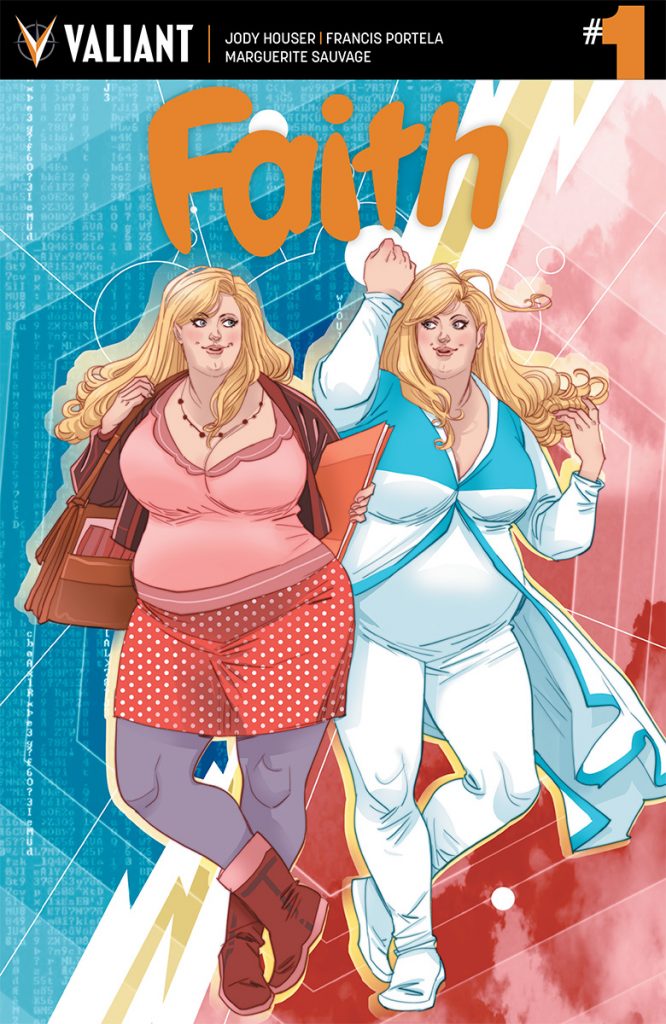
Follow-Up Reading Until Next Time
Comic Books Are Not Sexist But They Are Not Feminist Either presents a reasonable argument: that comics are at least not sexist in the manner they are often facilely accused of.
The Hawkeye Initiative draws male comic characters in female clothes and poses to illustrate that there is a difference in how they are treated. Like, duh.
A Quora Debate covers the question as well. It addresses lesbians and hyper-sexualized depictions of women in comics. Which I would argue is by default not going to be the same as straight men looking at women with at least an unconscious eye towards reproductive fitness.
Rachel Edidin (an editor at Dark Horse) thinks the answer is purge comics of it’s genre-centrism and return to a world of a wide variety of comics, where everybody can co-exist. And she makes an interesting case for the institutional sexism of super-hero comics writing, which is not what I’m talking about here. But still, interesting!

So, that’s it until Part III!
If you missed it, be sure to check out Part I.
Arcanaut out.
[amazon_link asins=’B01L0VXZAO,B000RFNBTK,B00I3OIESU,B015OY36P2,140125974X,B07B2D5XDV,B019YQAD5C,B01BEXG2P8′ template=’ProductCarousel’ store=’filmgoblin-20′ marketplace=’US’ link_id=’1488edf1-3ce7-11e8-9110-dd34fb30d904′]



